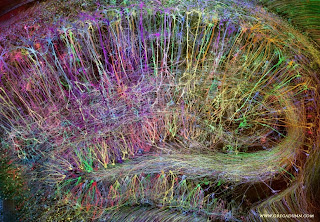My favorite exhibit by far was a collection of floral stereoradiographs by Albert G. Richards. I grew up surrounded by gardens and colorful flowers, and as a result have always been extremely fascinated with them. This collection was an entirely new take on their appearance. Radiographs are typically associated with the medical field and employ radiation, typically e-rays or gamma rays, to produce images. Stenographs, like the ones at the museum, use multiple radiographs from different angles to create a stereoscopic effect. The use of medical technologies to create art was, in my opinion, one of the most interesting intersections between art and science that we have learned about in this class. As such, it was incredible to see such spectacular images first hand.
Another fascinating and incredible exhibit was a collection of micromosaics by Henry Dalton. These pieces of art were created by peeling individual scales off of the wings of a variety of butterfly species and positioning them to create dazzlingly intricate, and amazingly small, mosaic pieces of art on little slides. Dalton's interest in science, which ultimately led him down the path to creating those micromosaics, is a prime example of how science can influence art and how scientific tools, like microscopes, can be used in conjunction with classic art techniques.
This last exhibit, which I could not bare to leave out, highlighted the Dogs of the Soviet Space Program. It featured Laika, the first animal sent into space, a topic I researched extensively after learning about her in the lecture on Space + Art due to my love of animals.
The Museum of Jurassic Technology was without a doubt my favorite out of the four museums I explored for this class because of its quirky and unconventional nature. I felt right at home with the fun and interesting vibe and it was completely worth the drive (although I would drive even further to visit it again with friends.).
Images:
[1] http://www.mjt.org/exhibits/alRichards/10.html
[2] http://www.mjt.org/exhibits/dalton/slide2.html#
[3] http://www.mjt.org/recentaddtions/creatures.html

























_page_79.png)